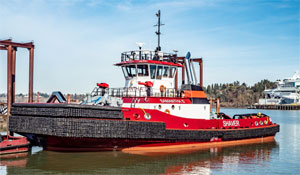Shaver Transportation has added a brawny new tugboat capable of handling just about any work that comes its way.
Samantha S. is an 8,432-hp powerhouse built with a striking square bow. With over 110 tons of bollard pull, the tug is easily the most powerful on the Columbia River. It is slated to join Shaver’s fleet based in Portland, Ore., around June 1.
Diversified Marine built the vessel in Portland based on a Jensen Maritime Consultants design. Samantha S. is intended to be a true utility player, handling ship assist and docking, offshore rescue tows and barge tows. The unusual square bow will be handy escorting big ships through the notorious Columbia River Bar.
“If a ship crosses the bar without escort, enters the narrow fairway of the channel and loses control, you have a hell of a mess,” said Fred Harding, a Shaver port captain. “This tug is specifically designed to do that work.”
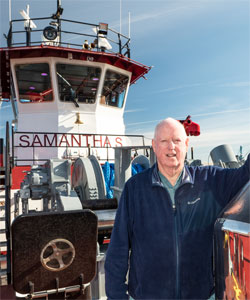 |
|
Port captain Fred Harding and other Shaver officials worked together to fine-tune the design for Samantha S. |
Samantha S., named for company president Steve Shaver’s sister, evolved several times over the years. It was initially planned as a replica to Shaver’s 80-foot Sommer S. built in 2012. The hull was first stretched to 90 feet, and then ultimately built to the final 112 feet.
Plans for a new Tesoro-Savage oil terminal near Vancouver, Wash., influenced the larger design. That project, which would have introduced large oil tankers into the Columbia River, faced opposition from environmental groups and never materialized. Shaver went ahead with the new tugboat anyway to meet demands on the Columbia and beyond.
At the Shaver Transportation office, moorage and shop along the Willamette River, Steve Shaver described building a boat to meet river and bar pilots’ wants and needs. “The tug,” he said, “has piqued everybody’s interest in the area.”
No surprise there. Successive generations of Shavers have responded to changing markets on the Columbia River system with innovative tug design. George Washington Shaver founded the People’s Freighting Company in 1880. He joined with his sons, James and George, to form Shaver Transportation in 1893. The modern company focuses on ship assist, inland grain and bulk commodity barge transport, and harbor services.
 |
|
The wheelhouse is equipped with modern navigation electronics from Furuno and Simrad. |
Steve Shaver, Harding and fellow port captain Brad Korpela deliberated for a long time on how to explain the design concept to Jensen and Diversified. During simulator testing at MITAGS-PMI, they found that the 90-foot tug design, when towing a ship across the Columbia Bar, was in irons every time and on one occasion rolled over, Harding explained.
“Each year the Coast Guard issues an average of six Captain of the Port orders, calling for an escort tug to attend a large ship across the bar,” Harding said. The call for escort is predicated on sea conditions, the size of the ship and the cargo — the goal being for the tug to stop a ship as fast as, or faster than, the ship itself can.
After determining the average stern length on the Shaver fleet, Harding and Korpela asked Jensen to add 20 percent more length to the new tug design. For propulsion, they chose GE 12V250, Tier 4, medium-speed diesel mains shafted to Rolls-Royce 305 z-drives with four-blade props.
Other considerations regarding the size of the tug were influenced by the increased horsepower, additional fuel capacity and accommodations for the 10 crew needed for long offshore emergency tows.
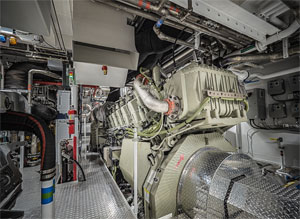 |
|
Propulsion comes from twin GE Tier 4 mains each rated for 4,216 hp. |
Jonathan Parrott, senior naval architect at Jensen, said Shaver specifically wanted to observe how the tug handled in the company’s favored escort mode. That involves hard-wiring the tugboat to the transom of the ship, similar to a Mississippi River barge-tow makeup.
While much of the Columbia is plenty wide, some stretches are much tighter. That limits the ability to perform standard indirect escort maneuvers. The tug acts like an outboard motor to the ship when hard-wired to the transom, Parrott noted.
“There was concern over how the tug would react if the lines to the ship parted on one side,” he said. “Simulations showed that the tug could still exert some force in such a condition, and more importantly, the tug would not be put in a condition that would endanger the tug and crew.”
The square 29-foot bow on Samantha S. is smothered in Schuyler Cos. fendering. With six or eight face wires, the load will be distributed to prevent stress on the ship’s transom. The unusual escort mode results in Samantha S. serving as a second engine and steering system for the ship. Shaver adopted this towing method because it offers quicker response time and more control if the ship encounters a sudden emergency.
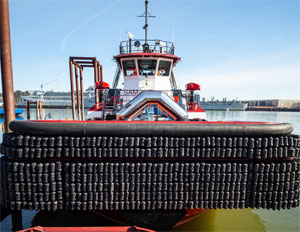 |
|
Samantha S. has a brawny, square bow smothered in Schuyler Cos. fendering. |
The deck winch configuration consists of six 120-ton Wintech winches on the stern and two on the foredeck. Under heavy load, the winches have an air brake to loosen the lines if trouble occurs in order to prevent damage to the ship’s bitts. They also have a dog pin if needed, and a tension indicator that lets the winch operator monitor the capacity and ease tension if necessary.
Simulator testing also showed additional length between the tug’s transom and towing winch provided better control and handling of the tug. Ten feet of length was added to the stern to increase the tow line distance from the winch to the hold downs, resulting in better tracking.
“Jensen came up with a 112-foot tug outside the rubber and a 110-ton bollard pull. There’s nothing with that kind of bollard pull on the river,” Harding said, noting that the beefed-up design was able to stop a ship one ship length faster than the ship could stop itself.
On the aft deck is a double-drum Rapp AHTW-75H-165 towing winch. Both drums are underwound, one with 3,000 feet of 2.5-inch galvanized wire and a 500-foot pennant of 3.125-inch Samson AmSteel-Blue line, and the other wound with 1,000 feet of 3.125-inch AmSteel-Blue.
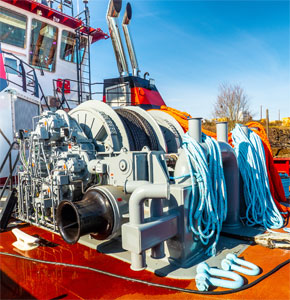 |
|
Samantha S. has a Rapp Marine double-drum towing winch aft, as well as six 120-ton Wintech deck winches at the stern. Two more 120-ton deck winches are installed on the foredeck along with a Rapp hawser winch. |
The Rapp hawser winch is a 900-hp hydraulic winch that will auto-tension at 100 tons of bollard pull. “The auto-tension works like a fishing reel,” Harding said. “We call it a 900-hp fishing reel.”
Harding and Korpela chose Rapp towing and escort winches because the company responded favorably to what the port captains wanted, rather than what the winch companies said they should have. Both winches were custom built at Rapp’s Serbia facility. “We wanted a true auto-tensioning winch that was not just a dog leash,” Harding said.
The tug also carries an Emergency Vessel Attached Towing System (EVATS) designed and manufactured by Samson Rope and Glosten. EVATS is a bridle system that threads the bow staple and distributes the load over five bitts on the port and starboard bow of a ship in distress.
A 1,300-hp Caterpillar C32 engine doubles as a winch motor and power supply for the fire pump system supplied by FFS. Samantha S. carries an FFV1 firefighting notation.
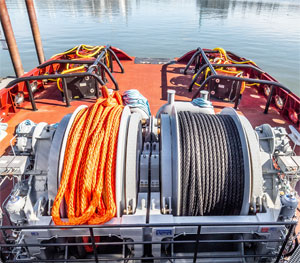 |
|
Taken together, the towing system aboard Samantha S. allows for maximum flexibility no matter what kind of work is needed. |
Since Kurt Redd founded Diversified Marine 35 years ago, towing houseboats on the Columbia with an 18-foot tug, the company has built tugs for several big West Coast operators. Samantha S. is its second delivery for Shaver.
“It’s a very complex boat with a lot of hydraulic piping — lots of it,” said Eric Hunter, Diversified’s project manager. “The complexity for the winch hydraulics in terms of pressures and routing the piping — it took eight months to do it. But it all worked and was ABS certified.”
At the end of March, Samantha S. remained at the Shaver dock undergoing last-minute tweaking and finalizing internal systems. April and May were devoted to trials, crew training and a bollard pull test. Samantha S. should be in service in June.
Developing a design that fit the company’s needs and could handle a wide range of work took some time. But that effort paid off. “The boat,” Harding said, “turned out great.”

